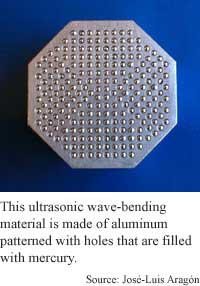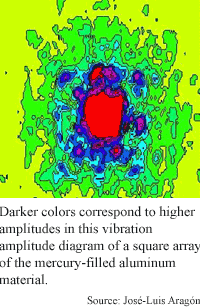
Material
bends sound waves
By
Kimberly Patch,
Technology Research NewsWhile a lot of research has gone into figuring out how to manipulate lightwaves for applications like optical communications, there's been substantially less attention paid to sound waves, which work on the same principle but are much longer.
The visible and infrared light wavelengths used in optical communications are around 500 nanometers long, while ultrasonic waves measure about a millimeter. Sound waves audible to the human ear range from about 22 millimeters to about 22 meters.
Researchers from Spain and Mexico have built a device that bends ultrasound waves as much as 90 degrees. The manipulation is an early step in a field that may one day produce devices that manipulate sound in much the same way mirrors and lenses manipulate light. The researchers' methods may also translate to the realm of light, where they have potential to increase the control of lightwaves in optics devices.
The researchers' ultrasonic twinned crystal device is made of a composite material -- 2-centimeter-thick aluminum alloy patterned with cylindrical holes filled with mercury.
This phononic material guides sound waves in the same way that electronic materials guide electrons, and photonic materials guide photons. "The composite materials used in these experiments are the phononic equivalent of an insulator," said José-Luis Aragón, a researcher at the National University of Mexico's Laboratory of Applied Physics.
To make the device bend sound waves, the researchers oriented three squares, or domains of the material, at 45 degree angles to each other. At certain frequencies, "waves traveling along one domain are capable of penetrating the second domain," essentially bending at the angle the domains are oriented to each other, said Aragón.
The principle is the same as lightwaves bending, or refracting when they travel from air to water, producing the familiar bent-drinking-straw effect. "It is an extreme refraction phenomenon," Aragón said.
The effect is caused by the interference of sound waves scattering off the mercury rods. This interference happens at different frequencies depending on the direction of the wave because the spacing between the rods is different at different angles.
The key to the researchers' approach is it does not require a full bandgap. A phononic bandgap prevents a certain frequency of sound waves from passing through a material in any direction. Previous attempts to control the direction of ultrasonic waves propagating through a material were generally focused on using structural defects to form full bandgaps in the materials, a difficult prospect.
The research is "an interesting example of how composite... phononic materials can be constructed with unusual wave properties," said John Page, a professor of physics at the University of Manitoba in Canada. In order to be practical, however, the material will have to be improved, he added. Sound attenuates, or fades quickly "even in the easy direction. They will need to improve this to make a useful filter out of their wedge."
The research may eventually improve photonic materials as well, because both light and sound exhibit similar wave phenomena, Page said. "The area where the concept illustrated by the ultrasonic wedge would be most useful is analogous optical -- photonic -- materials, where new ways of beam steering could have applications in photonic devices for optical communications," Page said.
The researchers are working to improve the attenuation tendency so the material will allow sound through without the sound waves fading so quickly, said Aragón. "The next step is to design an ultrasonic bandgap material with low intrinsic losses [and with it make] the acoustic equivalent of various electronic or optical elements, such as mirrors [and] lenses," he said. This will take around five years, he added.
In theory, phononic materials could eventually be used in circuits: "even switches and transistors could be fabricated," Aragón said.
Aragón's research colleagues were Manuel Torres from the Spanish Council for Scientific Research's Institute of Applied Physics and Francisco R. Montero de Espinoza from the Spanish Council for Scientific Research's Institute of Acoustics. They published the research in the May 7, 2001 issue of Physical Review Letters. The research was funded by the Spanish Ministry of Education.
Timeline: 5 years
Funding: Government
TRN Categories: Materials Science and Engineering
Story Type: News
Related Elements: Technical paper, "Ultrasonic Wedge for Elastic Wave Bending and Splitting without Requiring a Full Band Gap," Physical Review Letters, May 7, 2001.
Advertisements:
June 6, 2001
Page One
Search scheme treads lightly
Bug-eye lenses set up desktop chipmaking
DNA parts make versatile nanotubes
Watermarks hide in plain text
Material bends sound waves


News:
Research News Roundup
Research Watch blog
Features:
View from the High Ground Q&A
How It Works
RSS Feeds:
News
Ad links:
Buy an ad link
| Advertisements:
|
 |
Ad links: Clear History
Buy an ad link
|
TRN
Newswire and Headline Feeds for Web sites
|
© Copyright Technology Research News, LLC 2000-2006. All rights reserved.